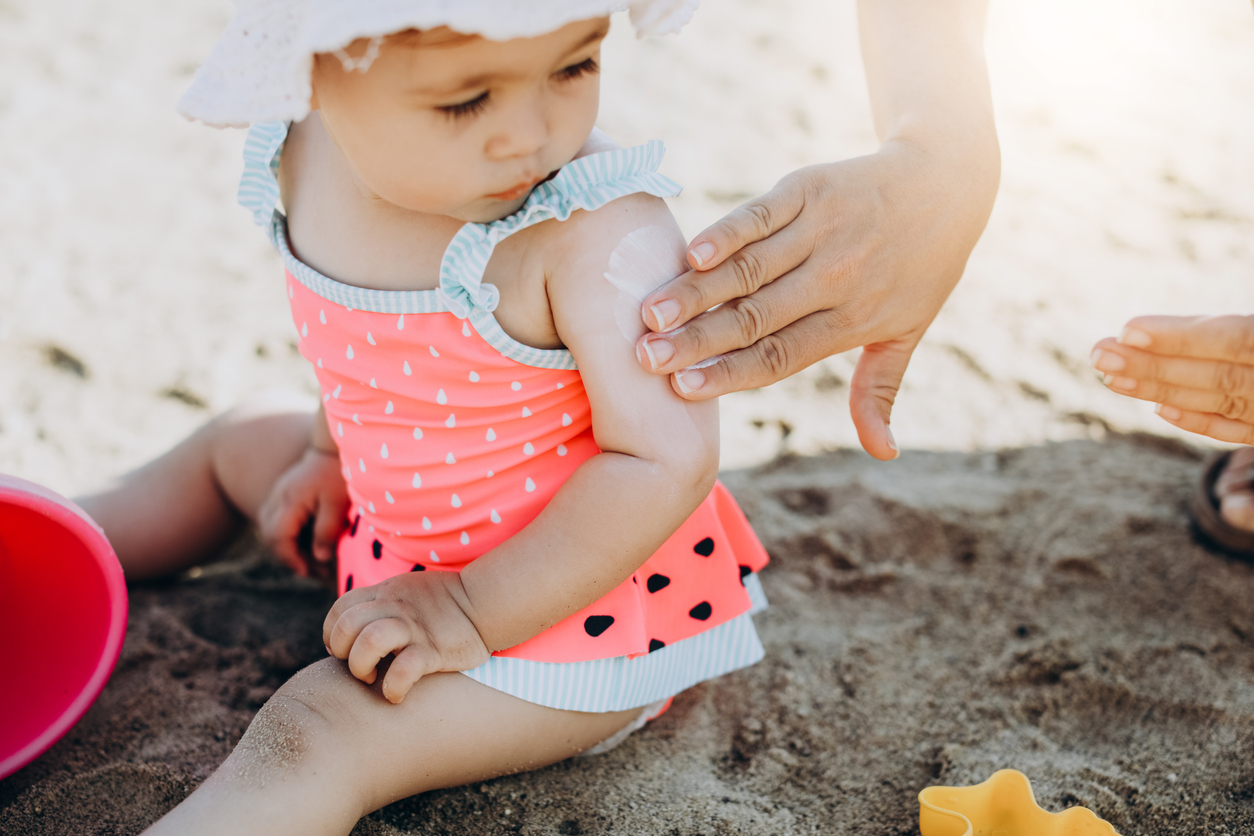As we embrace the sunny days, we must discuss a key ally in our family's health: sunscreen.
Protecting our little ones from the sun's rays is essential, whether it's a trip to the beach or a day at the park. Dr. Marisa Quattrone from Blueberry Pediatrics shares her expert advice to keep your child's skin safe and healthy.
Key Takeaways:
1. Mineral sunscreens with titanium dioxide and zinc oxide are recommended for children with sensitive skin or conditions like eczema for safe and effective sun protection.
2. Applying sunscreen with SPF 30, which blocks about 97% of UVB rays, is generally advised for children, with reapplication every two hours and after swimming or sweating.
3. Combining sunscreen with sun-protective clothing, like hats and UV-blocking sunglasses, along with post-sun exposure care, such as hydrating the skin, is essential for comprehensive sun protection for children.
Why is sunscreen important for kids?
Sunscreen is our first line of defense against the sun’s harmful ultraviolet (UV) rays. These rays can cause sunburns, which not only hurt but also can increase your child’s risk of developing skin cancer later in life.
Broad-spectrum sunscreens are recommended because they protect against UVA and UVB rays, offering a wide range of protection crucial for maintaining healthy skin.
Dr. Quattrone explains, “The irony is that the sun, which gives us life, can also harm us. That’s why sunscreen is critical to your sun safety plan.”
Can babies wear sunscreen?

Yes, but with specific guidelines. When choosing sunscreen, select products specifically designed for babies and toddlers.
Baby sunscreen offers SPF protection and is formulated to be gentle, hypoallergenic, and suitable for young, sensitive skin.
Dr. Quattrone advises applying sunscreen only on small areas like the face and back of the hands for babies under six months. For those older than six months, sunscreen can be used more liberally. Just be careful around their eyes!
This is a good opportunity to prioritize protective clothing to minimize the need for the overall amount of sunscreen!
Can toddlers wear sunscreen?
Toddlers can and should use sunscreen. "Make sure to cover all exposed skin, as toddlers often move around a lot and can easily miss spots," says Dr. Quattrone.
Choosing the right sunscreen: mineral vs chemical
When choosing between mineral and chemical sunscreens, Dr. Quattrone recommends mineral options.
“Mineral sunscreens sit on the skin and reflect UV rays away. They’re also less likely to cause skin reactions, making them a safer choice for your children,” she notes.
Mineral sunscreen options are particularly beneficial for kids with sensitive skin or eczema. "Titanium dioxide and zinc oxide are common active ingredients, contributing to their effectiveness and safety for children," says Dr. Quattrone.
Be sure to purchase a mineral sunscreen lotion free of biologically harmful chemicals like avobenzone, oxybenzone, and parabens. The Environmental Working Group's sunscreen guide is a great resource for finding options for your family.
<div fs-richtext-component="cta" class="content_cta">
<div class="content-cta__title">
<div class="y-tex-xxs text-color-white">
Blueberry - Rated best for online pediatrics!
</div>
</div>
<div class="y-text-2xl text-color-white">
👩🏽⚕️ Chat With A Pediatrician About Your Child's Symptoms
</div>
<a href="https://app.blueberrypediatrics.com/join_blueberry_18a_cart?promo=blog100"
target="_blank" class="content-cta_btn w-button">
Get Started
</a>
<link rel="prefetch" href="https://app.blueberrypediatrics.com/join_blueberry_18a_cart?promo=blog100">
The role of SPF in sunscreen
SPF, or Sun Protection Factor, measures how well a sunscreen can protect against UVB rays. "An SPF of 30 is generally recommended for children, as it blocks about 97% of UVB rays," Dr. Quattrone advises. General guidelines on SPF levels:
- SPF 15 blocks 93% of UVB rays
- SPF 30 blocks 97% of UVB rays
- SPF 50 blocks 98% of UVB rays
Most dermatologists recommend using an SPF of at least 30 for all ages, as there is no evidence that using a very high SPF will provide any additional protection.
When should sunscreen be applied?

Applying SPF should be a daily regimen as UV rays are present all year round! Apply sunscreen 25 minutes before exposure to the sun.
How often should sunscreen be reapplied?
"It’s important to reapply sunscreen every two hours or immediately after swimming or sweating," says Dr. Quattrone. This ensures continuous protection, especially during peak sun exposure between 10 AM and 4 PM.
Sunscreen and clothing: working together
While sunscreen is vital, combining it with sun-protective clothing can provide the best protection. Clothes designed for sun protection, with a tight weave or special coating, can significantly reduce UV exposure. "Don’t forget a wide-brimmed hat and UV-blocking sunglasses," adds Dr. Quattrone.
After sun exposure: caring for your child’s sensitive skin
After a day in the sun, it’s important to hydrate and soothe your child's skin. A cool bath or aloe vera can help with any mild sunburn. "If there are more severe reactions like blisters, or if your child feels unwell, seek medical advice promptly," Dr. Quattrone recommends.
Special considerations: kids with skin conditions
Choosing the right sunscreen is crucial for children with skin conditions such as eczema.
“Mineral sunscreens are generally better tolerated by children with sensitive skin,” Dr. Quattrone suggests, recommending brands like ThinkSport and Badger for their gentle formulations.
Ingredients like caprylhydroxamic acid and various seed oils are found in mineral sunscreens, making them suitable for children with sensitive skin or conditions like eczema.
Keep your little ones protected with Blueberry Pediatrics
Dr. Quattrone encourages all parents to use sunscreen as a daily routine for their children. "It’s about creating safe sun habits early on," she concludes. "This way, you can enjoy the beautiful days ahead with peace of mind, knowing your children are protected."
Have questions about sunscreen or sun safety? Blueberry pediatricians have answers! Blueberry Pediatrics, one of the largest pediatric practices in the US, provides 24/7 access to board-certified pediatricians via phone, text, or video. Our board-certified pediatricians are here to help you with all your pediatric health concerns, ensuring your little ones get the best care possible.
Families get unlimited care for all the children in their household, without leaving home, for one low monthly or annual fee. You can get care as soon as today when you sign up.
.png)
Sources
- How to decode sunscreen labels. (n.d.). Www.aad.org. https://www.aad.org/public/everyday-care/sun-protection/shade-clothing-sunscreen/understand-sunscreen-labels
- The Skin Cancer Foundation. (2019, June). UV Radiation - The Skin Cancer Foundation. The Skin Cancer Foundation; The Skin Cancer Foundation. https://www.skincancer.org/risk-factors/uv-radiation/
- Adams, M. (2022, June 30). Mineral or chemical sunscreen: Which should you choose? MD Anderson Cancer Center. https://www.mdanderson.org/cancerwise/is-mineral-sunscreen-better-than-chemical-sunscreen.h00-159540534.html
Frequently Asked Questions
What are UVA/UVB rays?
UV rays, or ultraviolet radiation, are emitted from the sun, are classified as wavelength A or B, and have different effects on the body. UVA rays penetrate the skin and impact skin aging, while UVB rays sit on top of the skin and cause sunburn.
What’s the difference between mineral sunscreen and chemical sunscreen?
The primary difference between mineral and chemical sunscreen is their interaction with the sun's UV rays. Mineral sunscreen reflects UV rays, while chemical sunscreen absorbs them.
What are the ingredients in mineral sunscreen lotion?
The active ingredients in mineral sunscreens are titanium dioxide and zinc oxide, which create a barrier on your skin that reflects UV light so it doesn't absorb into the skin.
Is sunscreen water-resistant?
There's no such thing as waterproof sunscreen. Sweat and water wash sunscreen from our skin, so it's important to reapply sunscreen regularly when swimming or playing.








.svg)






.svg)
.svg)